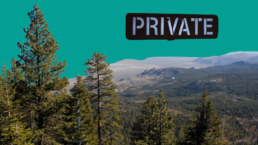Most of the places that should be protected do not belong to federal lands. More than half of the country’s forests are privately owned
By Jordan G. Teicher, TheBaffler
When the billionaire John Malone became the country’s largest private landowner in 2011 with the purchase of nearly a million acres of forest in Maine and New Hampshire, it sparked a great deal of curiosity in the press. Why, reporters wanted to know, did a then-seventy-year-old media tycoon want to own 2.2 million acres of land—an area roughly half the size of Lake Ontario?
Malone has offered a variety of mundane reasons over the years, including his Irish heritage, his wife’s horseback riding hobby, and the joy he takes in being “out in the open.” The most creative among them, though, came during a CNBC interview, when he described his decades-long land binge as a kind of affliction, a “virus” passed on to him by his friend, CNN founder Ted Turner—a fellow billionaire who, after Malone’s 2011 purchase, became merely the second-largest land baron in the country.
If a lust for land among the billionaire class is a virus, it has become something of an epidemic recently. In 2007, the nation’s hundred largest private landowning families owned a combined 27 million acres of land—an area, as the Washington Post reported, the size of Maine and New Hampshire combined. By 2017, they’d increased their haul by nearly 50 percent to encompass an area equivalent to all of New England minus Vermont. In the pages of The Land Report—a magazine that covers land ownership—wealthy readers can browse new potential additions to their territory: a mountain range for $60 million, a collection of watersheds and creeks for $68 million, a “combination of landscapes” for $96 million.

If a lust for land among the billionaire class is a virus, it has become something of an epidemic recently. In 2007, the nation’s hundred largest private landowning families owned a combined 27 million acres of land—an area, as the Washington Post reported, the size of Maine and New Hampshire combined. By 2017, they’d increased their haul by nearly 50 percent to encompass an area equivalent to all of New England minus Vermont. In the pages of The Land Report—a magazine that covers land ownership—wealthy readers can browse new potential additions to their territory: a mountain range for $60 million, a collection of watersheds and creeks for $68 million, a “combination of landscapes” for $96 million.
Recent Posts
Nigerian Village Bombed by Trump Has ‘No Known History’ of Anti-Christian Terrorism, Locals Say
December 28, 2025
Take Action Now “Portraying Nigeria’s security challenges as a targeted campaign against a single religious group is a gross misrepresentation of…
How Effective Are Protests? Historians Say: Very.
December 27, 2025
Take Action Now Protests change the protesters, their communities and the nation. From emancipation to women’s suffrage, civil rights and BLM, mass…
The United States’ Hidden History Of Regime Change—Revisited
December 26, 2025
Take Action Now The truculent trio—Trump, Hegseth, and Rubio—do Venezuela.By Barbara Koeppel, The Nation Since the early 20th century, the United…
The “President Of Peace” Prepares For War
December 23, 2025
Take Action Now The Donroe Doctrine Hits HomeBy William D. Hartung, Tom Dispatch Earlier this month, the Trump administration released its new…




